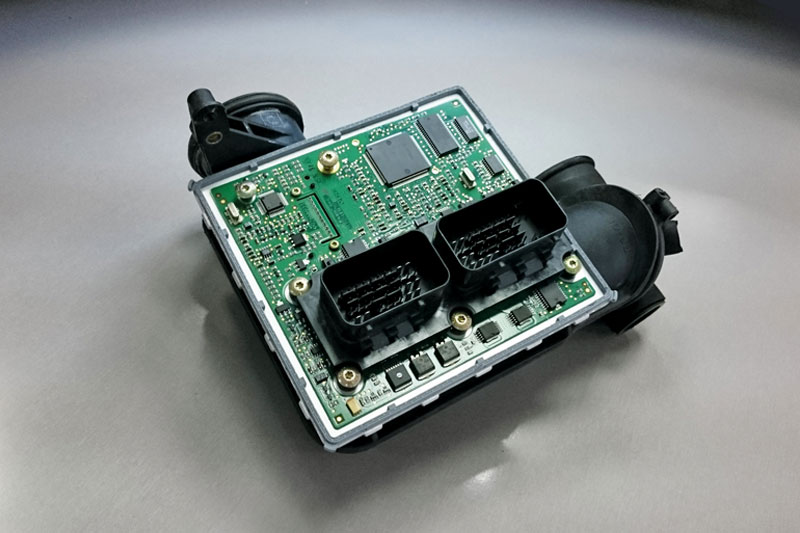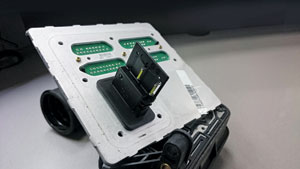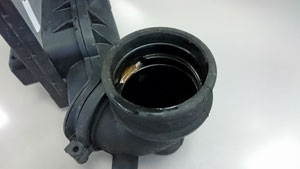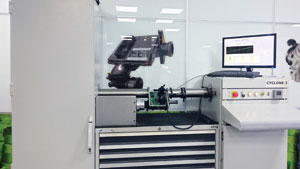
Thijs Jasnik, COO, ACtronics, explains the technology behind a Mercedes-Benz A-Class (W168) with VDO ECU.
Because cars are packed with comfort and safety features these days, it’s getting increasingly difficult to fit in every little component. This situation isn’t likely to improve at any point in the near future – especially under the bonnet – so manufacturers are now starting to look for clever solutions. Perhaps that’s why VDO/Mercedes-Benz asked the question: “Why would you fit the ECU (Engine Control Unit) and AFM (Air Flow Meter) separately, when it’s possible to combine them into one single component?” And that’s exactly what has been done in the Mercedes A-Class. Maybe the odd shape of this ECU (which seems directly melted onto the air intake) looks a little confusing at first glace but, in reality, it really does save you space.
Furthermore, both the air intake and the ECU need stable conditions with constant low temperatures, so this configuration also makes it a lot easier to create the overall layout of the engine bay – you’ll only need one area with low temperatures, because the air intake and ECU are literally fused into one part. So far this configuration seems to have no down-sides.
What’s causing the main malfunctions?
But what if either the ECU itself or the air flow sensor fails? Unfortunately this delicate air flow sensor is also the weakest link of this combined ECU. The most common complaint is stalling of the engine at idle, and we’ve also had reports of power loss and odd O2- sensor readings as well.
In almost every case each of these symptoms are the result of a faulty AFM. What most people don’t realise while diagnosing the complaint is that even if the faulty AFM still seems to work, the sensor could still be the source of all the problems. In some cases the air flow sensor slowly loses its accuracy; once this symptom occurs, the measured air flow doesn’t match the reality anymore. The ECU then makes a miscalculation that results in a wrong air/fuel ratio.
So what makes diagnosing a defective AFM difficult?
A defective AFM may not always trigger fault codes, but that doesn’t mean everything works properly. Even if the AFM does trigger fault codes the readings could still be quite confusing as you’ll often encounter fault codes relating to ignition, injection and air/fuel ratio. The list shows you some common fault codes that may indicate a faulty AFM.
These fault codes are just a few examples of the types that may appear. All fault codes from P1000 to P1999 are specific codes that have different meanings, depending on which car manufacturer uses the ECU. Therefore we can assume there will also be fault codes relating to a faulty AFM in these ranges.
P0100 Mass or volume air flow, implausible signal
P0101 Air mass sensor, implausible signal
P0102 Air mass sensor, signal too low
P0103 Air mass sensor, signal too high
P0104 Air mass sensor, sporadic interference
P0129 Barometric pressure too low
P0130 Oxygen sensor, circuit failure in Bank 1 – Sensor 1
P0136 Oxygen sensor, implausible signal in Bank 1 – Sensor 2
P0169 Fuel mixture not right
P0170 Fault in system, fuel mixture adjustment
P0171 Composition air/fuel mixture too lean
P0172 Composition air/fuel mixture too rich
P0173 Incorrect calculation air/fuel mixture in Bank 2
P0174 Air/fuel mixture too lean in Bank 2
P0175 Air/fuel mixture too rich in Bank 2
P0176 Fuel mixture sensor fault circuit
P0177 Fuel mixture sensor, implausible signal
P0178 Sensor fuel composition, signal too low
P0179 Fuel mixture sensor, low input
Remanufacturing: the process
So must repairers would be forgiven for thinking: “Well, we’ll just replace the air flow meter and we’re done, right?” This, however, is not the case as the AFM is directly mounted onto the PCB of the ECU itself. What also needs to be taken into consideration is that ACtronics has a strict policy of solving the problem, rather than simply replacing a defective part.
What are we doing?
The remanufacturing process begins with the dismantling of the outer shell. The plastic tube in which the AFM is located usually contains quite a bit of oil and even a tiny amount of oil can damage the air flow sensor.
Therefore, this tube will be replaced with a clean one from our stocks. We also check if all seals are intact and replace them, if needed.
Once we’ve opened the combined ECU, we focus on the AFM. The first thing we have to do is replace the two sensors on the outside of the AFM. We never opt for the widely available ‘imitation’ sensors because it’s essential to use sensors with the same quality as OE in order to ensure longevity and accuracy. We therefore use exactly the same sensors as Mercedes-Benz themselves.These are very difficult to obtain, but ACtronics has found a reliable source.
Even after replacing these sensors, the remanufacturing process has not yet been completed. We also open the sensor housing in order to replace various components on the tiny PCB with new (better) ones. Once that process is complete, we assemble a new selfmade cover. This extra step means we can be confident that the remanufactured product is even better than OE.
Once the remanufactured AFM is installed back onto the PCB, the testing and finetuning begins. We have access to a sophisticated testing environment that was completely built and developed by our own R&D team – we call it the “Cyclone”.
 This system actually blows air through the air mass meter to mimic the operation while driving and this realistic simulation then enables us to adjust the remanufactured AFM with high accuracy. We use a small potentiometer in order to adjust the deviation within 0.03V. We know it would be a lot easier to simply copy the values of another AFM, but this doesn’t give us the level of quality and accuracy we want as each product has to be absolutely perfect. That’s also the reason for keeping up the development of our remanufacturing method, hence the Cyclone unit that we’re currently using is 3rd generation already.
This system actually blows air through the air mass meter to mimic the operation while driving and this realistic simulation then enables us to adjust the remanufactured AFM with high accuracy. We use a small potentiometer in order to adjust the deviation within 0.03V. We know it would be a lot easier to simply copy the values of another AFM, but this doesn’t give us the level of quality and accuracy we want as each product has to be absolutely perfect. That’s also the reason for keeping up the development of our remanufacturing method, hence the Cyclone unit that we’re currently using is 3rd generation already.
The result of this whole process is an ECU with an AFM that functions better and more accurately than the original. And let’s be honest now, would you still consider buying a new ECU – which could cost well over £500 – or would you rather choose a cheaper and better option?
The ECU in detail
It should be clear by now that the option of mounting the AFM directly onto the ECU wasn’t a smart choice. This configuration makes it impossible to simply replace the AFM and, although a direct connection of the AFM onto the PCB is less susceptible ton interference than a conventional separate sensor, it could also be a major disadvantage. The AFM has proven to be sensitive and often causes malfunctions. Therefore, simple replacement should be possible.
 Fortunately the ECU itself has no further surprises. All there is to see is a relatively simple PCB with two large connectors. As with almost any ECU connectors, they’re intentionally shaped differently in order to prevent the wiring harness from being connected incorrectly. The outer housing isn’t equipped with cooling fans, however malfunctions relating to high temperatureshaven’t been observed so far. Apparently, the architecture of the ECU and the position in the engine bay are both well thought out. Besides the input from the AFM, the VDO ECU also obtains inputs from various other sensors. It’s really important to gather as much information as possible in order to make the right decisions about timing for both ignition and injection. The graphic (pictured below) shows you several sensors that transmit values to the ECU.
Fortunately the ECU itself has no further surprises. All there is to see is a relatively simple PCB with two large connectors. As with almost any ECU connectors, they’re intentionally shaped differently in order to prevent the wiring harness from being connected incorrectly. The outer housing isn’t equipped with cooling fans, however malfunctions relating to high temperatureshaven’t been observed so far. Apparently, the architecture of the ECU and the position in the engine bay are both well thought out. Besides the input from the AFM, the VDO ECU also obtains inputs from various other sensors. It’s really important to gather as much information as possible in order to make the right decisions about timing for both ignition and injection. The graphic (pictured below) shows you several sensors that transmit values to the ECU.
After obtaining all of this information the ECU can now generate the right outputs for controlling ignition and injection. The Mercedes-Benz A140 has one combined coil that can actuate all spark plugs and the ECU uses two different signals for this operation. The injection system on the A140 engine is equipped with one single injector rail and four individual injectors that are each controlled separately by the ECU. This engine, however, doesn’t make use of direct injection – the actual injection takes place into the inlet manifold.
Everything the ECU needs to compute (base maps, calculation models etc.), is stored in a flash memory and the main processor uses all inputs and stored data to generate the required outputs. These outputs will then be sent to the correct actuator.

Disassembly of the ECU
At ACtronics, we always recommend the use of the official manufacturer’s instructions, so the following information is strictly for guidance only: The VDO ECU in the Mercedes-Benz A140 is hidden under a large cover on the right side of the engine block and the cover is secured by three screws. In order to remove the lower screw, the long inlet tube on the front of the engine has to be removed first.
Once both the tube and the cover are removed, the VDO ECU becomes visible. It’s wise to release the two large connectors at the rear of the ECU before it becomes completely disassembled. After this is done, it’s just a matter of unscrewing both pipes on the side of the ECU. You can now remove the ECU from the car.









